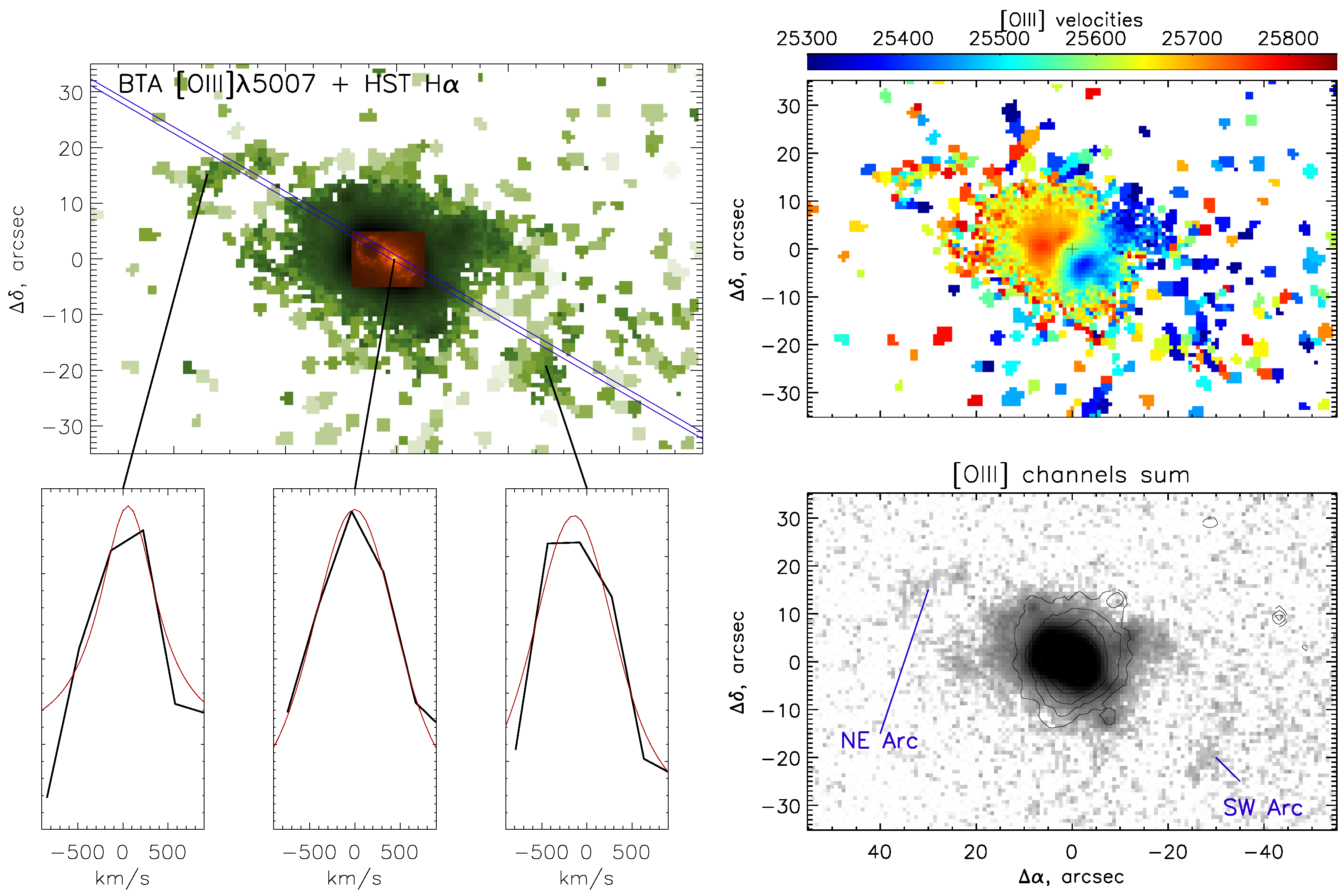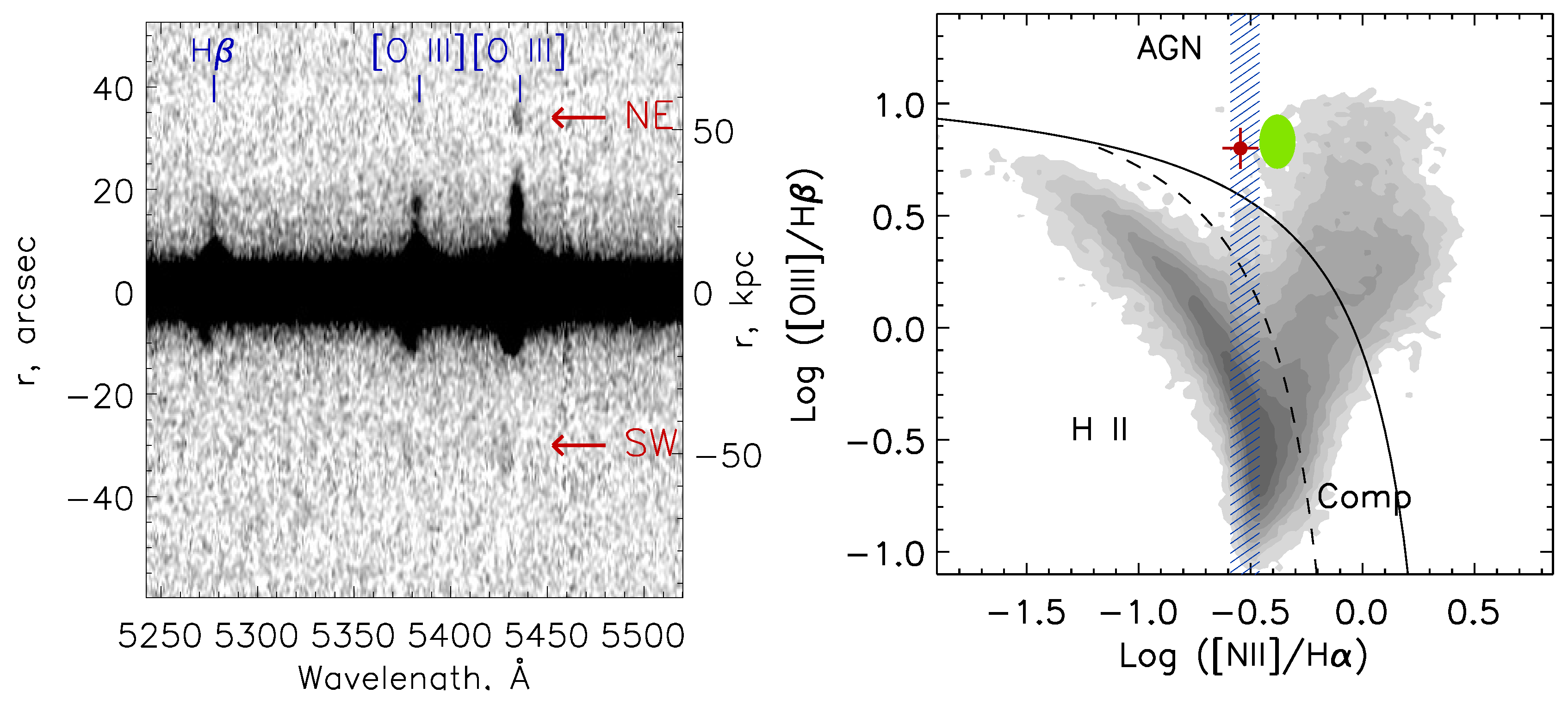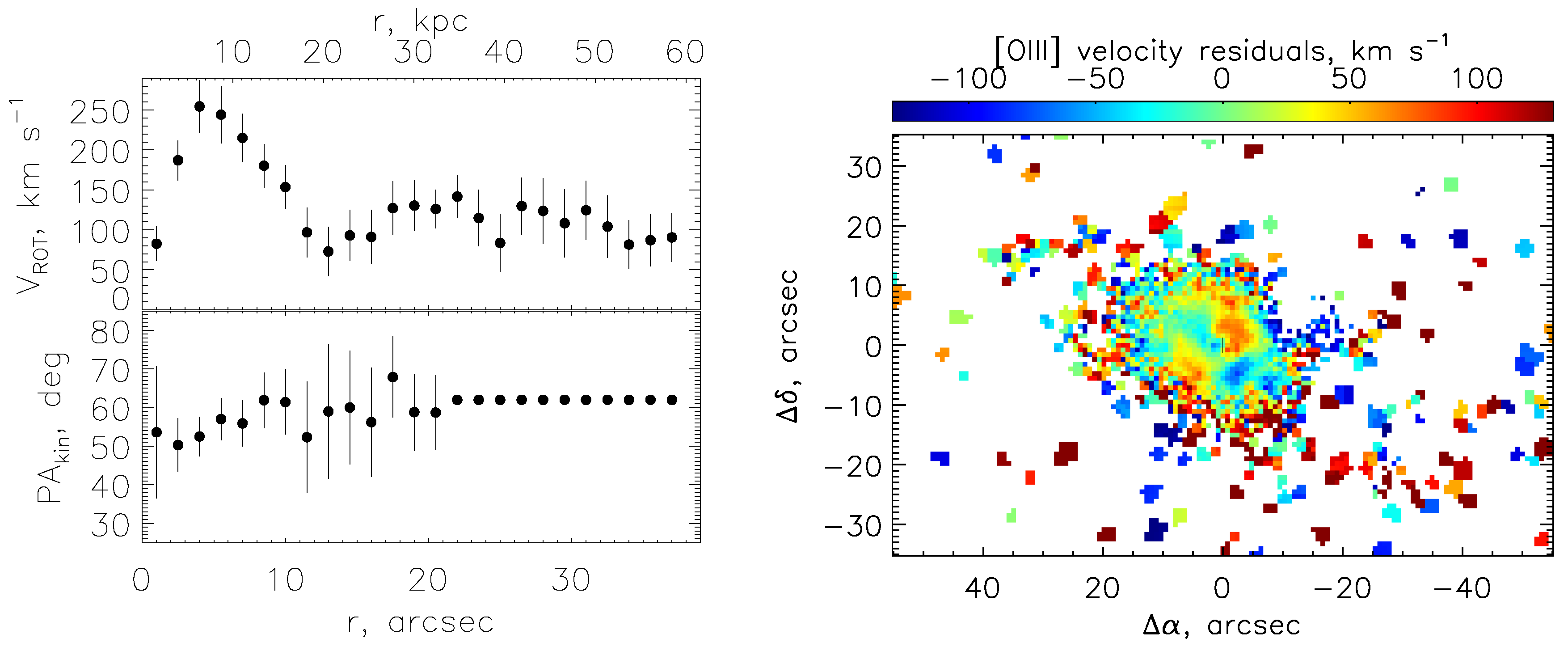Gas and Stars in the Teacup Quasar Looking with the 6-m Telescope
Abstract
1. Introduction
2. Observations and Data Analysis
3. The Stellar Population Properties and Kinematics
4. The Gas Ionization
5. The Extended Nebula: Morphology and Kinematics
6. Discussion
7. Conclusions
- The indicative line ratio I([O III] 5007)/I(H)) was directly estimated for the external regions (19–41 kpc) of the Teacup nebula. The obtained value lies in the range 0.7–0.9 presented by Gagne et al. [11] for the nearest to the AGN region. Together with the I([N II])/I(H) ratio obtained early on in the GTC observations it confirms that the domination of AGN radiation in gas ionization is in good agreement with the conclusion of the paper [13];
- The stars in the inner kpc are significantly younger and richer in metal than the outer host galaxy. The starburst age (∼1 Gyr) agrees with the timescale of a merger event, as proposed by Keel et al. [8];
- The ionized gas velocity field can be described in the term of a circular rotating disk with a flat rotation curve up to distances 50–60 kpc. This disc appears to be significantly inclined or even polar to the stellar host galaxy;
- The deep map of the [O iii] emission reveals two symmetric arcs in the external region of the EELR (r = 50–55 kpc). It might be a remnant of the previous AGN outflow (it may be in a combination with a starburst-driven galactic wind) with the age < 0.8 Gyr.
Author Contributions
Funding
Institutional Review Board Statement
Informed Consent Statement
Data Availability Statement
Acknowledgments
Conflicts of Interest
Abbreviations
| ASC | Advanced Camera for Surveys |
| EELR | Extended Emission-Line Regions EELR |
| FPI | Fabry–Perot interferometer |
| GTC | Gran Telescopio Canarias |
| HST | Hubble Space Telescope |
| SAO RAS | Special Astrophysical Observatory of the Russian Academy of Sciences |
| SSP | Single stellar population |
References
- Smirnova, A.A.; Moiseev, A.V.; Dodonov, S.N. A close look at the well-known Seyfert galaxy: Extended emission filaments in Mrk 6. Mon. Not. R. Astron. Soc. 2018, 481, 4542–4547. [Google Scholar] [CrossRef]
- Morganti, R. Archaeology of active galaxies across the electromagnetic spectrum. Nat. Astron. 2017, 1, 596–605. [Google Scholar] [CrossRef]
- Knese, E.D.; Keel, W.C.; Knese, G.; Bennert, V.N.; Moiseev, A.; Grokhovskaya, A.; Dodonov, S.N. An [O iii] search for extended emission around AGN with H I mapping: A distant cloud ionized by Mkn 1. Mon. Not. R. Astron. Soc. 2020, 496, 1035–1050. [Google Scholar] [CrossRef]
- Keel, W.C.; Moiseev, A.; Kozlova, D.V.; Ikhsanova, A.I.; Oparin, D.V.; Uklein, R.I.; Smirnova, A.A.; Eselevich, M.V. The TELPERION survey for distant [O iii] clouds around luminous and hibernating AGN. Mon. Not. R. Astron. Soc. 2022, 510, 4608–4625. [Google Scholar] [CrossRef]
- Gagne, J.; Crenshaw, D.M.; Keel, W.C.; Fischer, T.C. Optical Spectra of the Teacup AGN. Am. Astron. Soc. Meet. Abstr. 2011, 217, 142.12. [Google Scholar]
- Keel, W.C.; Lintott, C.J.; Maksym, W.P.; Bennert, V.N.; Chojnowski, S.D.; Moiseev, A.; Smirnova, A.; Schawinski, K.; Sartori, L.F.; Urry, C.M.; et al. Fading AGN Candidates: AGN Histories and Outflow Signatures. Astrophys. J. 2017, 835, 256. [Google Scholar] [CrossRef]
- Lansbury, G.B.; Jarvis, M.E.; Harrison, C.M.; Alexander, D.M.; Del Moro, A.; Edge, A.C.; Mullaney, J.R.; Thomson, A.P. Storm in a Teacup: X-ray View of an Obscured Quasar and Superbubble. Astrophys. J. Lett. 2018, 856, L1. [Google Scholar] [CrossRef]
- Keel, W.C.; Maksym, W.P.; Bennert, V.N.; Lintott, C.J.; Chojnowski, S.D.; Moiseev, A.; Smirnova, A.; Schawinski, K.; Urry, C.M.; Evans, D.A.; et al. HST Imaging of Fading AGN Candidates. I. Host-galaxy Properties and Origin of the Extended Gas. Astrophys. J. 2015, 149, 155. [Google Scholar] [CrossRef]
- Harrison, C.M.; Thomson, A.P.; Alexander, D.M.; Bauer, F.E.; Edge, A.C.; Hogan, M.T.; Mullaney, J.R.; Swinbank, A.M. Storm in a “Teacup”: A Radio-quiet Quasar with ≈10 kpc Radio-emitting Bubbles and Extreme Gas Kinematics. Astrophys. J. 2015, 800, 45. [Google Scholar] [CrossRef]
- Keel, W.C.; Chojnowski, S.D.; Bennert, V.N.; Schawinski, K.; Lintott, C.J.; Lynn, S.; Pancoast, A.; Harris, C.; Nierenberg, A.M.; Sonnenfeld, A.; et al. The Galaxy Zoo survey for giant AGN-ionized clouds: Past and present black hole accretion events. Mon. Not. R. Astron. Soc. 2012, 420, 878–900. [Google Scholar] [CrossRef]
- Gagne, J.P.; Crenshaw, D.M.; Kraemer, S.B.; Schmitt, H.R.; Keel, W.C.; Rafter, S.; Fischer, T.C.; Bennert, V.N.; Schawinski, K. Spatially Resolved Spectra of the “Teacup” Active Galactic Nucleus: Tracing the History of a Dying Quasar. Astrophys. J. 2014, 792, 72. [Google Scholar] [CrossRef]
- Ramos Almeida, C.; Piqueras López, J.; Villar-Martín, M.; Bessiere, P.S. An infrared view of AGN feedback in a type-2 quasar: The case of the Teacup galaxy. Mon. Not. R. Astron. Soc. 2017, 470, 964–976. [Google Scholar] [CrossRef]
- Villar-Martín, M.; Cabrera-Lavers, A.; Humphrey, A.; Silva, M.; Ramos Almeida, C.; Piqueras-López, J.; Emonts, B. A 100 kpc nebula associated with the ‘Teacup’ fading quasar. Mon. Not. R. Astron. Soc. 2018, 474, 2302–2312. [Google Scholar] [CrossRef]
- Villar Martín, M.; Emonts, B.H.C.; Cabrera Lavers, A.; Bellocchi, E.; Alonso Herrero, A.; Humphrey, A.; Dall’Agnol de Oliveira, B.; Storchi-Bergmann, T. Interactions between large-scale radio structures and gas in a sample of optically selected type 2 quasars. Astron. Astrophys. 2021, 650, A84. [Google Scholar] [CrossRef]
- Afanasiev, V.L.; Moiseev, A.V. Scorpio on the 6 m Telescope: Current State and Perspectives for Spectroscopy of Galactic and Extragalactic Objects. Balt. Astron. 2011, 20, 363–370. [Google Scholar] [CrossRef]
- Egorov, O.V.; Lozinskaya, T.A.; Moiseev, A.V.; Smirnov-Pinchukov, G.V. Star formation complexes in the ‘galaxy-sized’ supergiant shell of the galaxy HolmbergI. Mon. Not. R. Astron. Soc. 2018, 478, 3386–3409. [Google Scholar] [CrossRef]
- Moiseev, A.; Perepelitsyn, A.; Oparin, D. Mapper of Narrow Galaxy Lines (MaNGaL): New tunable filter imager for Caucasian telescopes. Exp. Astron. 2020, 50, 199–214. [Google Scholar] [CrossRef]
- Moiseev, A.V. Scanning Fabry-Perot Interferometer of the 6-m SAO RAS Telescope. Astrophys. Bull. 2021, 76, 316–339. [Google Scholar] [CrossRef]
- Cappellari, M.; Copin, Y. Adaptive spatial binning of integral-field spectroscopic data using Voronoi tessellations. Mon. Not. R. Astron. Soc. 2003, 342, 345–354. [Google Scholar] [CrossRef]
- Moiseev, A.V.; Egorov, O.V. Reduction of CCD observations made with the Fabry-Perot scanning interferometer. II. Additional procedures. Astrophys. Bull. 2008, 63, 181–192. [Google Scholar] [CrossRef]
- Cappellari, M. Improving the full spectrum fitting method: Accurate convolution with Gauss-Hermite functions. Mon. Not. R. Astron. Soc. 2017, 466, 798–811. [Google Scholar] [CrossRef]
- Vazdekis, A.; Sánchez-Blázquez, P.; Falcón-Barroso, J.; Cenarro, A.J.; Beasley, M.A.; Cardiel, N.; Gorgas, J.; Peletier, R.F. Evolutionary stellar population synthesis with MILES—I. The base models and a new line index system. Mon. Not. R. Astron. Soc. 2010, 404, 1639–1671. [Google Scholar] [CrossRef]
- Groves, B.; Brinchmann, J.; Walcher, C.J. The Balmer decrement of Sloan Digital Sky Survey galaxies. Mon. Not. R. Astron. Soc. 2012, 419, 1402–1412. [Google Scholar] [CrossRef]
- Young, L.M.; Serra, P.; Krajnović, D.; Duc, P.A. The diversity of atomic hydrogen in slow rotator early-type galaxies. Mon. Not. R. Astron. Soc. 2018, 477, 2741–2759. [Google Scholar] [CrossRef]
- Gasymov, D.; Katkov, I. Detailed study of galaxies with the stellar counter-rotation phenomenon. arXiv 2022, arXiv:2209.11240. [Google Scholar]
- Sil’chenko, O.K.; Moiseev, A.V.; Egorov, O.V. The Gas Kinematics, Excitation, and Chemistry, in Connection with Star Formation, in Lenticular Galaxies. Astrophys. J. Suppl. Ser. 2019, 244, 6. [Google Scholar] [CrossRef]
- Baldwin, J.A.; Phillips, M.M.; Terlevich, R. Classification parameters for the emission-line spectra of extragalactic objects. Publ. Astron. Soc. Pac. 1981, 93, 5–19. [Google Scholar] [CrossRef]
- Kewley, L.J.; Groves, B.; Kauffmann, G.; Heckman, T. The host galaxies and classification of active galactic nuclei. Mon. Not. R. Astron. Soc. 2006, 372, 961–976. [Google Scholar] [CrossRef]
- Kewley, L.J.; Dopita, M.A.; Sutherland, R.S.; Heisler, C.A.; Trevena, J. Theoretical Modeling of Starburst Galaxies. Astrophys. J. 2001, 556, 121–140. [Google Scholar] [CrossRef]
- Kauffmann, G.; Heckman, T.M.; Tremonti, C.; Brinchmann, J.; Charlot, S.; White, S.D.M.; Ridgway, S.E.; Brinkmann, J.; Fukugita, M.; Hall, P.B.; et al. The host galaxies of active galactic nuclei. Mon. Not. R. Astron. Soc. 2003, 346, 1055–1077. [Google Scholar] [CrossRef]
- Thomson, R.C. Shell formation in elliptical galaxies. Mon. Not. R. Astron. Soc. 1991, 253, 256. [Google Scholar] [CrossRef]
- Feldmann, R.; Mayer, L.; Carollo, C.M. Tidal Debris in Elliptical Galaxies as Tracers of Mergers with Disks. Astrophys. J. 2008, 684, 1062–1074. [Google Scholar] [CrossRef]
- Petersson, J.; Renaud, F.; Agertz, O.; Dekel, A.; Duc, P.A. From starburst to quenching: Merger-driven evolution of the star formation regimes in a shell galaxy. arXiv 2022, arXiv:2210.16333. [Google Scholar] [CrossRef]
- López-Cobá, C.; Sánchez, S.F.; Anderson, J.P.; Cruz-González, I.; Galbany, L.; Ruiz-Lara, T.; Barrera-Ballesteros, J.K.; Prieto, J.L.; Kuncarayakti, H. The AMUSING++ Nearby Galaxy Compilation. I. Full Sample Characterization and Galactic-scale Outflow Selection. AJ 2020, 159, 167. [Google Scholar] [CrossRef]





| Mode | Date of Obs. | , s | , | , Å | , Å |
|---|---|---|---|---|---|
| Long-slit | 11 February 2018 | 2.2 | 3500–7220 | 5 | |
| FPI | 19 April 2020 | 3.2 | 5410–5470 | 13 | |
| FPI | 24 April 2020 | 1.6 | 5410–5470 | 13 |
Disclaimer/Publisher’s Note: The statements, opinions and data contained in all publications are solely those of the individual author(s) and contributor(s) and not of MDPI and/or the editor(s). MDPI and/or the editor(s) disclaim responsibility for any injury to people or property resulting from any ideas, methods, instructions or products referred to in the content. |
© 2023 by the authors. Licensee MDPI, Basel, Switzerland. This article is an open access article distributed under the terms and conditions of the Creative Commons Attribution (CC BY) license (https://creativecommons.org/licenses/by/4.0/).
Share and Cite
Moiseev, A.V.; Ikhsanova, A.I. Gas and Stars in the Teacup Quasar Looking with the 6-m Telescope. Universe 2023, 9, 66. https://doi.org/10.3390/universe9020066
Moiseev AV, Ikhsanova AI. Gas and Stars in the Teacup Quasar Looking with the 6-m Telescope. Universe. 2023; 9(2):66. https://doi.org/10.3390/universe9020066
Chicago/Turabian StyleMoiseev, Alexei V., and Alina I. Ikhsanova. 2023. "Gas and Stars in the Teacup Quasar Looking with the 6-m Telescope" Universe 9, no. 2: 66. https://doi.org/10.3390/universe9020066
APA StyleMoiseev, A. V., & Ikhsanova, A. I. (2023). Gas and Stars in the Teacup Quasar Looking with the 6-m Telescope. Universe, 9(2), 66. https://doi.org/10.3390/universe9020066







